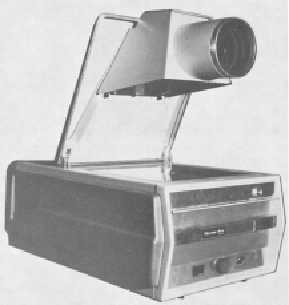perfect focus of the light rays which pass
through the lens.
Directly above the Fresnel lens is the 10-inch
by
10-inch
projection
stage
where
the
projectuals are placed. The objective (projection)
lens is supported centrally over the stage, This
lens focuses the image of what is to be projected
onto a 45° front-surface mirror, which in turn
reflects the image to the screen.
Attachments may be provided that will allow
the overhead projector to be converted into a
device that will project 35-mm slides, 35-mm
strip film, or lantern slides. Additionally, a
polarized disk may be attached to the projector
allowing
specially
prepared
animation
projectuals to be shown which will give the
audience the effect of movement.
Portable Overhead Projector
The portable overhead projector is a self-
contained unit. (See figure 7-6.) Due to the
142.339.1
Figure 7-6.—Portable overhead projector.
unit’s portability, the space between the projection
stage and projection head is limited. As a result,
the use of this projector with overlay-type
projectuals is limited.
A unique feature of this device is that the
blower motor is thermostatically controlled. The
thermostat maintains a constant temperature in
the vicinity of the lamp which prolongs the lamp’s
life. When the two-position switch is turned ON,
power is applied to both the projection lamp and
the blower motor. When the air passing around the
projection lamp is heated to 130°F, a thermostatic
switch closes, providing a secondary path for
electrical power to the blower motor. When the
projector switch is turned OFF the blower motor
will continue to operate until the thermostatic
switch opens. The thermostatic switch will open
when the temperature of the air passing around
the projection lamp falls below 130°F, For this
reason power should not be removed from the
device until the blower motor shuts off
automatically.
The overhead projector, shown in figure 7-7, is
another type of portable self-contained unit.
Overlay-type projectuals that do not extend
beyond the top of the viewing stage can be used
with this projector.
This device uses a quartz iodine lamp instead of
the standard projection lamp. The transparent
envelope is made from quartz (in-stead of glass).
Quartz resists heat and permits use of higher
wattage. Caution must be observed when handling
the quartz lamp. Stains from fingerprints can
cause lamp failure. When lamp failure occurs, the
lamp may explode when lighted. For this reason a
safety switch cuts off the current to the lamp when
the projector top is open.
Opaque Projector
The basic difference between the opaque
projector and the overhead type is that light is
reflected from the surface of opaque objects rather
than passing through them. (See figure 7-8.)
Examples of opaque objects that can be
7-18


